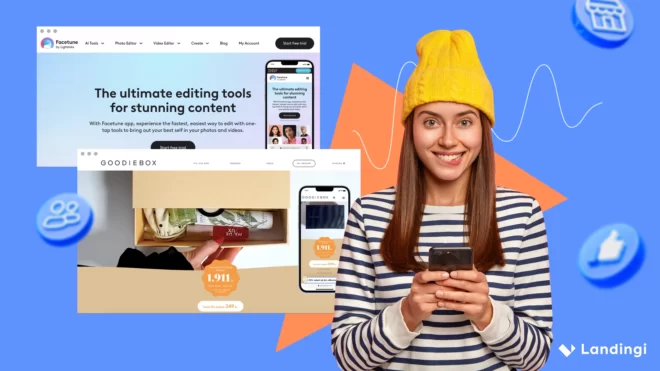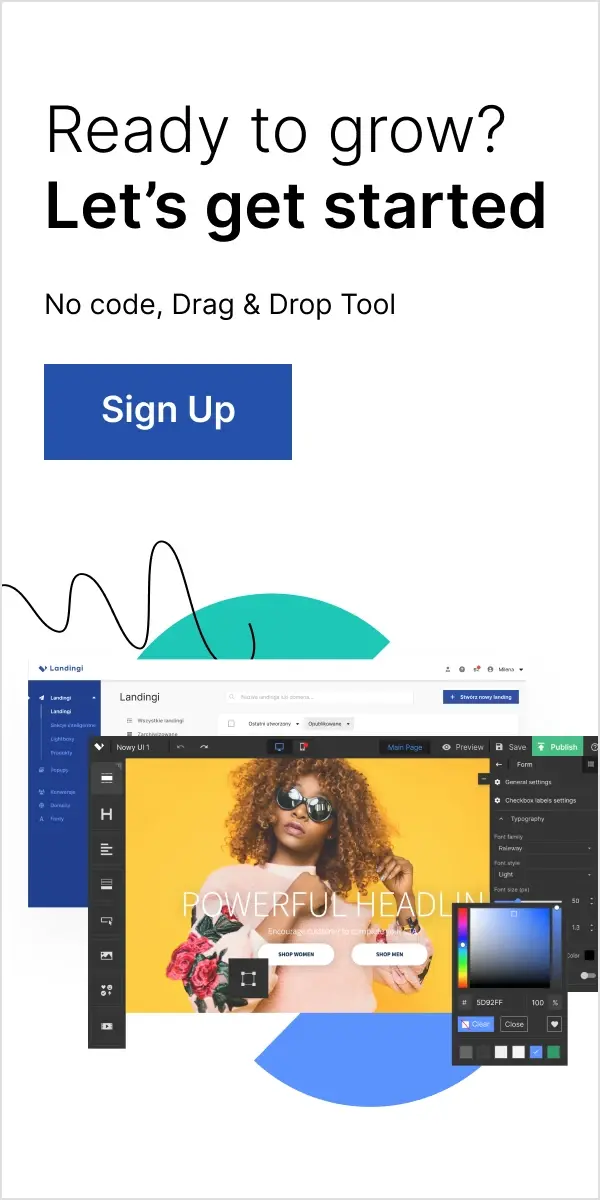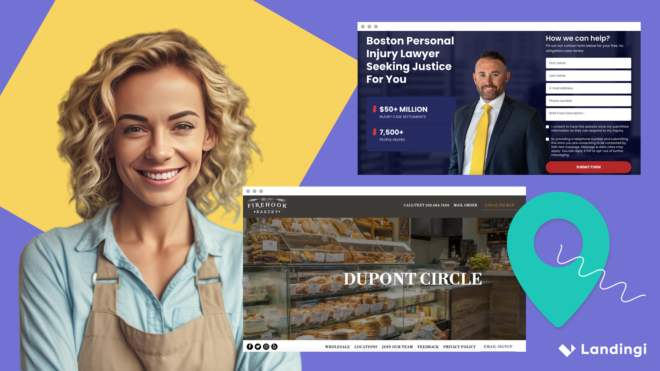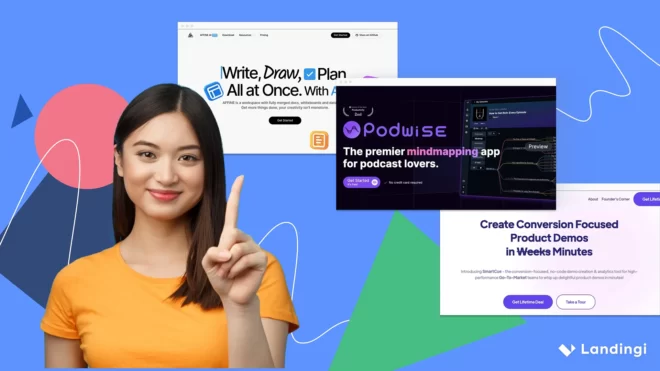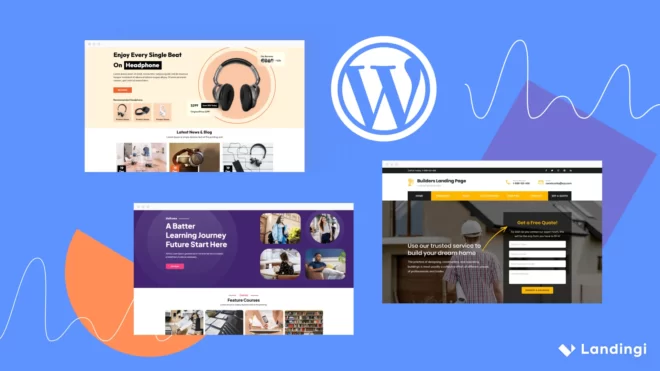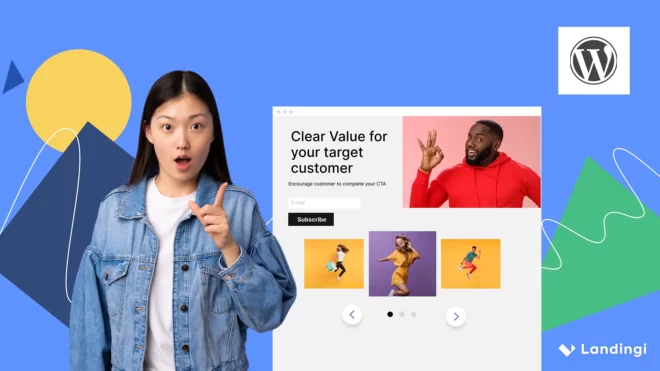A Facebook landing page is a tailored web page created specifically for Facebook users that aims to optimize social interactions and conversions directly through the platform. Serving as a pivotal component of a social media marketing strategy, it harnesses Facebook’s vast user base to direct traffic, promote engagements, and convert visitors into leads or customers.
This article will delve into the best practices for designing a Facebook landing page that not only draws attention but effectively channels that interest into actionable outcomes. We provide a comprehensive guide to creating a Facebook landing page that converts. By reviewing six exemplary cases, we will illustrate how various brands successfully leverage their Facebook presence to meet diverse business objectives, such as increasing event attendance, boosting product sales, or growing email subscriptions.
For a good start, take a look at the 5 tips on creating perfect landing pages for Facebook campaigns:
- Ensure your landing page is responsive to mobile devices and loads quickly on all screen sizes.
- Incorporate high-quality images or videos that align with your message and attract attention.
- Include a clear call to action.
- Display positive customer feedback to reassure new visitors of the value and quality of your offering.
- Ensure the content on your landing page is concise and directly related to the campaign objectives.
Discover the best Facebook landing page examples, get an in-depth look at their key elements, and get inspired to create your own landing page to drive successful campaigns.
- Facetune by Lightricks
- Goodiebox
- HP – for Business
- Essilor – Find an Eyecare Professional
- Wessper – D2 BOROSILICATE futureflow™
- Cosentino – Kitchen Renovation
Make your sections smartable and let go of mundane manual tasks with Smart Sections! An easy way to manage bulk changes.
What Is a Facebook Landing Page?
A Facebook landing page is a specialized page designed to capture the attention of users within the Facebook platform and encourage a specific action, such as signing up for a newsletter, registering for an event, or making a purchase. In contrast to standard web pages, a Facebook landing page is embedded within the Facebook ecosystem, enabling businesses to tap into Facebook’s extensive user base for targeted marketing efforts.
As powerful Facebook ad campaign components, these landing pages are created using Facebook’s custom tabs or through linked external sites that direct users from Facebook to a specific URL. The primary goal of such a page is to convert Facebook traffic into leads or sales without navigating users away from the platform, thereby maintaining a smooth and cohesive user experience.
Optimized for social sharing and engagement, these pages often include elements like sign-up forms, promotional videos, and CTA buttons that are tailored to the interests and browsing habits of Facebook users. By focusing on user interaction within the social media context, Facebook landing pages are an effective tool for boosting conversions in a familiar and frequently accessed environment.
How to Create a Landing Page for Facebook Ads?
To create a landing page for the Facebook ads, start by defining your objective and understanding your target audience, choose a landing page builder tailored to your needs, craft compelling content and add visually engaging elements, ensure the page is mobile–friendly, and never forget about continuous optimization through A/B testing. Follow the 8-step guide to achieve the best results:
1. Define your objectives
Firstly, clearly define your objectives – set up what you want to achieve with your Facebook Ads. Are you looking to generate leads, sell products, or increase event registrations? Your objectives will dictate the design and content of your landing page.
2. Understand your audience
Secondly, understand your audience – know who your target audience is, understand their preferences, pain points, and what they are likely to respond to. This insight will help you create a landing page that resonates with them and effectively addresses their needs.
3. Choose a landing page builder
Thirdly, choose a landing page builder – select a tool that offers the flexibility, design options, and features you need. Platforms like Landingi or Carrd offer templates and features that make it easy to create effective landing pages without needing to code.
4. Craft compelling content
Fourthly, craft compelling content – your landing page should have a clear headline that communicates the value of your offer. Include persuasive subheadings, engaging copy, and compelling visuals that align with the ad that brought the visitor to the page. Ensure that your message is concise and to the point.
And they are right – as proven by HubSpot reports, implementing videos on your landing page can increase conversion by up to 86%.
5. Design for conversion
Fifthly, design your page with conversion in mind – include a prominent CTA button that stands out and is easy to locate. Keep the design clean and user-friendly, with minimal distractions that could detract from the main conversion goal.
6. Incorporate social proof
Sixthly, incorporate social proof – adding elements like testimonials, customer reviews, or trust badges can significantly increase trust and conversions. These elements reassure visitors of the credibility and reliability of your offer.
7. Optimize for mobile
Seventhly, optimize your page for mobile – ensure that your landing page is mobile-friendly, and check that the page looks good and functions well on various devices and screen sizes.
8. Test and optimize
Lastly, test and optimize your landing page regularly – use A/B testing to try out different versions of your landing page and experiment with different headlines, CTAs, images, and layouts to see what works best. Analyze the performance using analytics tools, heatmaps, and event tracking tools to optimize and improve the page’s effectiveness based on real data.
By following these steps, keeping your target audience in mind, you can create a Facebook landing page that looks appealing and effectively converts visitors into leads or customers.
6 Best Examples of Facebook Landing Pages
Meet the 6 best examples of Facebook landing pages that successfully fulfill the objectives of marketing campaigns and bring good ROI. Each example breaks down the key elements that contribute to their success, including strategic design choices, compelling calls to action, and the smart integration of engaging content. Whether you are looking to refine your existing page or start from scratch, these insights will equip you with the knowledge to create a high-performing Facebook landing page.
1. Facetune by Lightricks
The Facetune by Lightricks Facebook landing page demonstrates best practices for engaging potential users and converting interest into action. The page is skillfully tailored to attract the attention of digital content creators and casual users alike, providing a streamlined experience from the initial view through to the call to action. It features vibrant, attention-grabbing visuals and clear, compelling copy that succinctly communicates the benefits and features of the Facetune app.

Strategically placed testimonials and user-generated content lend authenticity and trustworthiness, encouraging visitor engagement and conversions. Additionally, the seamless integration of social proof and direct calls to action, such as “Start Free Trial”, effectively guide users through the conversion funnel. The overall design is aesthetically pleasing and functional, emphasizing usability across devices and ensuring that visitors have a smooth, interruption-free experience navigating the page.
Key takeaways to learn from this example:
- Clear design aligned with a Facebook ad,
- Attractive visuals: pictures and animations,
- Concise, persuasive descriptions,
- Social proof elements,
- FAQ section,
- Strategically placed, outstanding CTA button,
- Mobile responsiveness.
Improvement areas:
- Videos – animations are great, but adding a short explainer video showcasing how the app works would boost users’ engagement, ultimately leading to higher conversion rates.
Choose the Your Music App template and change it into a perfectly tailored Facebook ad landing page for your campaign – its layout, focused on a single campaign goal, is designed to engage visitors from the first moments.
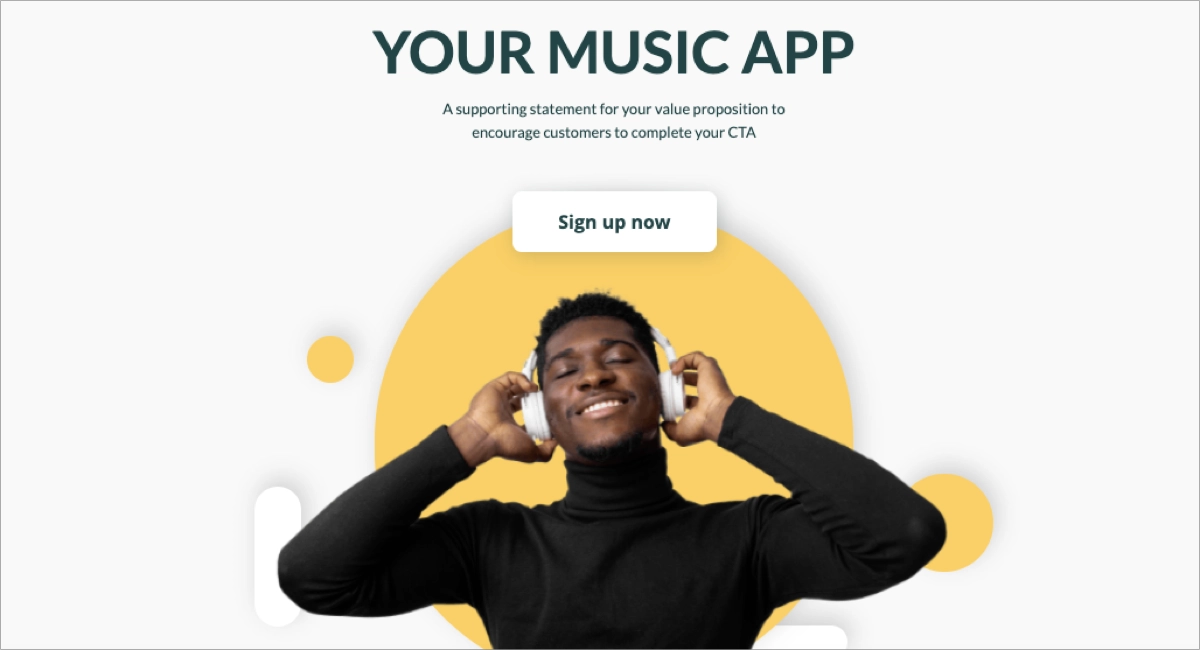
2. Goodiebox
The Goodiebox page used in their social media campaign stands out as an exemplary model in digital marketing strategy, particularly in the beauty subscription box market. This page effectively utilizes a vibrant and engaging design, featuring appealing visuals and concise, persuasive content that clearly communicates the value proposition of up to 70% savings on beauty products, sharing the same message as in the campaign ads. The design elements are carefully crafted to appeal to the aesthetic sensibilities of the target audience, encouraging them to explore the benefits of subscribing.

The page also implements an intuitive user interface that simplifies navigation and enhances user experience, making it easy to understand the offering and take the desired action. Strategic use of customer testimonials and trust badges further boosts credibility and helps convert visitors into subscribers. This comprehensive approach to design and content, aligned with user expectations and market trends, marks the Goodiebox Facebook landing page as one of the most successful pages.
Key takeaways to learn from this example:
- Intuitive layout,
- Engaging visuals,
- Attractive, clear offer,
- Popup with an irresistible offer,
- “How it works” section,
- Outstanding CTA,
- FAQ section,
- Mobile responsiveness.
Improvement areas:
- Loading time – the page is well-designed, but needs loading speed optimization to ensure seamless experience and prevent bounce rates.
The Spa Discount template is perfectly tailored to promote beauty products or services, including the benefits section, special offer section, outstanding CTAs, and clear form. Customize it by creating your unique selling proposition, add high-quality pictures and run your Facebook campaign.
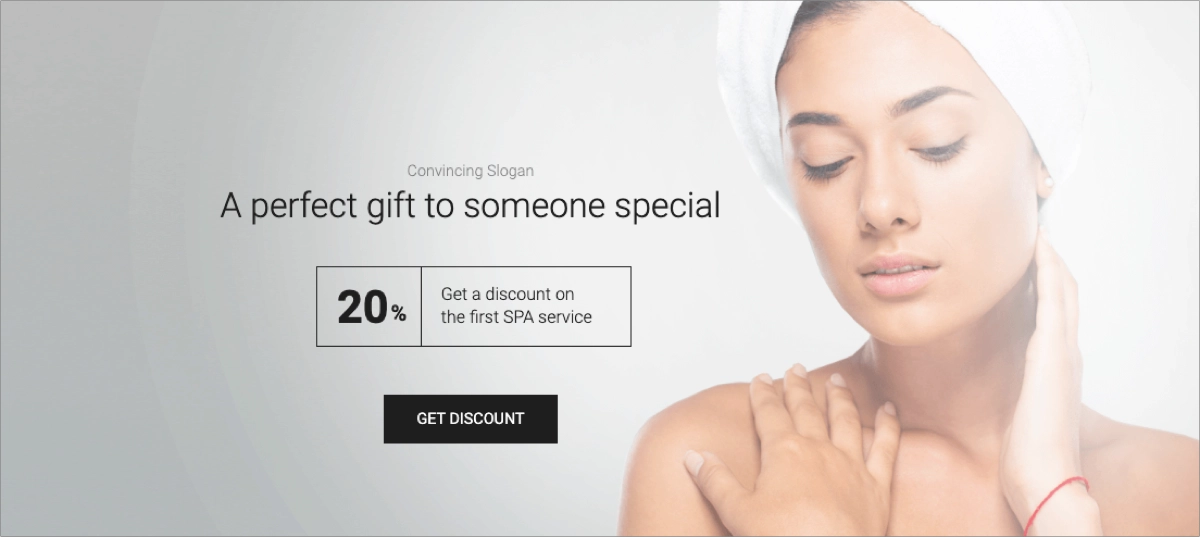
3. HP – for Business
The HP landing page created to promote business offers is perfectly tailored to its target audience. This page successfully employs a blend of functional design, clear messaging, and strong visual elements, attractive for their perfect customer. The use of bold, clear headlines and subheadings effectively communicates HP’s value proposition to business customers, emphasizing its range of products and services designed to enhance business operations.

The landing page is structured to facilitate easy navigation, ensuring that information about different business solutions is accessible within just a few clicks. Incorporating professional pictures adds an element of trust and authenticity, encouraging potential customers to explore HP’s offerings further. The strategic use of CTA buttons, which are prominently displayed, guides users towards specific actions. The main CTA on a sticky bar allows visitors to take immediate action, regardless of the trigger’s placement. A good practice incorporated on this page is adding “Call Now” button in the top-right corner.
Key takeaways to learn from this example:
- Simple design,
- Attention-grabbing headlines,
- Concise yet informative written content,
- Professional pictures,
- Outstanding, well-placed CTAs,
- “Call Now” button,
- Mobile responsiveness.
Improvement areas:
- Interactive elements – the page could include more interactive elements, animations or videos to engage visitors more and boost conversion rates.
Generate leads with an Electronics Discount template – direct users from FB ad to a perfectly crafted landing page that excels in guiding visitors to complete the desired action. Customize form, add attractive visuals, and drive high conversions.
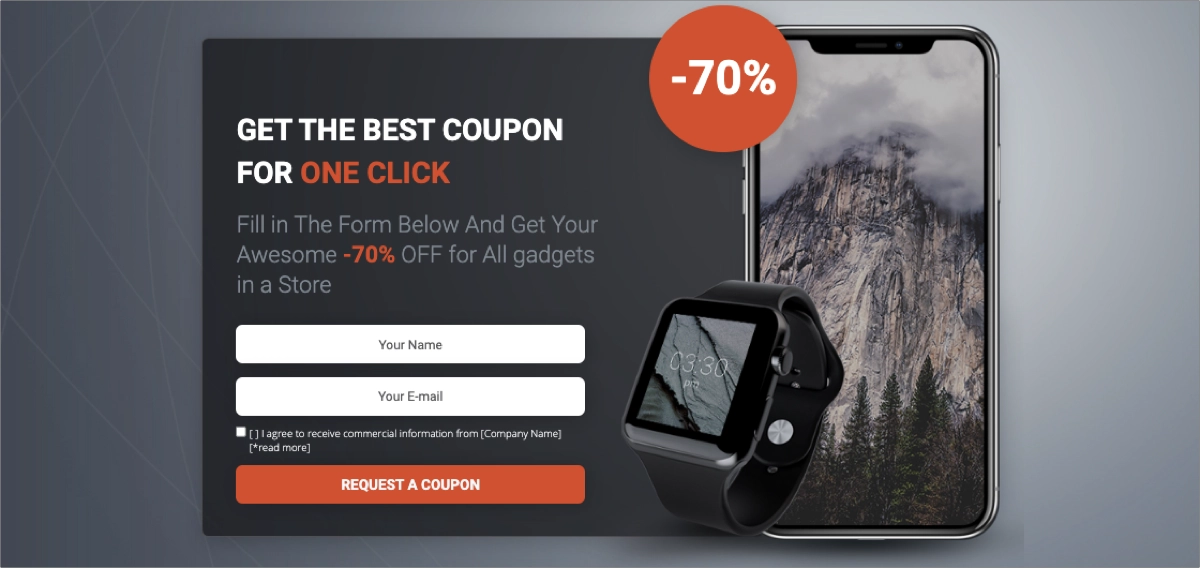
4. Essilor – Find an Eyecare Professional
The Essilor landing page – “Find an Eyecare Professional”, used in their Facebook campaign, is one of the best examples of driving digital strategies by providing users with useful and engaging resources. This landing page is designed with clarity and user convenience at its core, making it incredibly easy for users to locate and connect with eyecare professionals near them. The layout prominently integrates an intuitive search tool backed by a user-friendly interface that streamlines the process of finding the right eyecare services. This direct approach helps reduce user effort and enhance engagement, providing functionality.

Visual elements on the page are reduced to the minimum – the only graphic is the company logo, but half of the page takes an interactive map, which efficiently caters to visitors’ attention. Adding other elements would distract users from the main purpose. Additionally, the page is optimized for performance across all devices, ensuring a seamless experience whether accessed via desktop or mobile. Social proof elements like customer testimonials and expert endorsements are strategically placed to build trust and credibility among potential customers.
Key takeaways to learn from this example:
- Minimal layout,
- Engaging, functional tool,
- Compelling headline,
- Strategically placed search bar,
- Mobile responsiveness
Improvement areas:
- Content – the page works well; the only thing that could further engage visitors could be adding short instructions as an attractive subheading.
Drive more conversions with a perfectly tailored Facebook landing page – choose Clothing Sale – Squeeze Page template and create a minimal page with an irresistible offer!
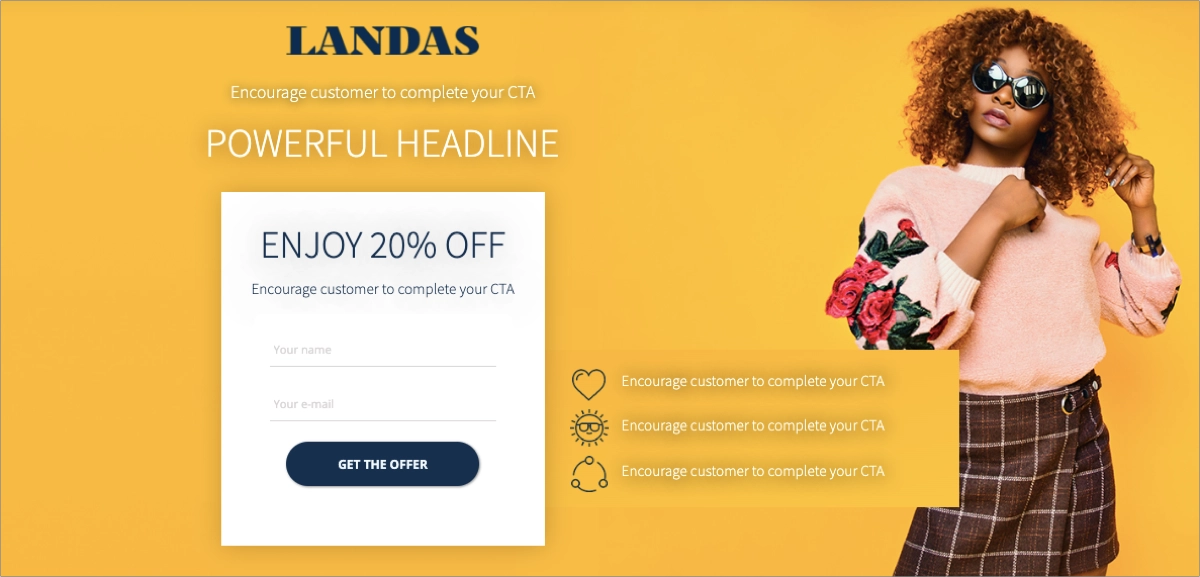
5. Wessper – D2 BOROSILICATE futureflow™
The D2 BOROSILICATE futureflow™ Facebook landing page by Wessper exemplifies an excellent approach to engaging users in the niche of home water filtration solutions. The page excels in clarity and visual appeal, featuring a clean, modern design focusing on the product’s benefits and unique selling points. The use of high-quality images, animated background, and well-structured content effectively communicates the value of Wessper’s jugs, emphasizing their efficiency and the health benefits they offer.

Moreover, the page includes a seamless navigation that allows users to easily find detailed product information, reviews, and purchasing options, enhancing user experience and encouraging conversions. Including social proof through trust badges further builds confidence in potential buyers, making the landing page a promotional tool and a resource for valuable customer insights.
Key takeaways to learn from this example:
- Intuitive yet immersive layout,
- Compelling headlines,
- Engaging visuals,
- Outstanding CTA buttons,
- Well-written benefits section,
- Purchasing options.
Improvement areas:
- Social proof – the page could include testimonials, as social proof efficiently increases conversions.
Create high-converting product pages that bring high ROI. Avoid common mistakes by choosing a well-designed Watch Sale template. Start building your page with Landingi, showcase your offer, and use it as a final point for Facebook advertising.
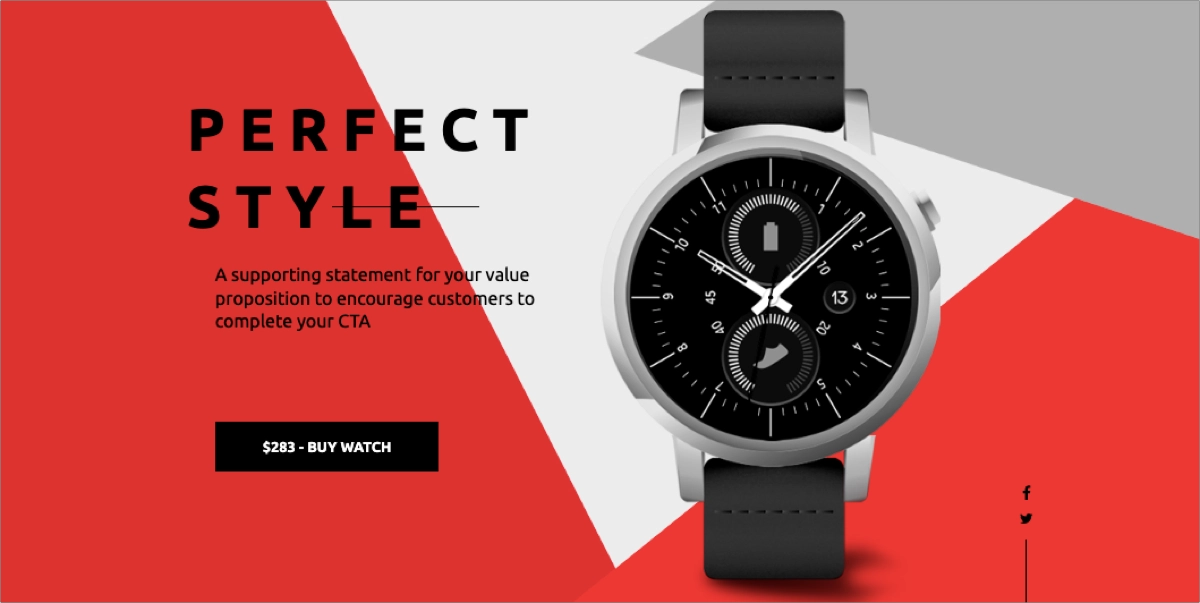
6. Cosentino – Kitchen Renovation
Cosentino’s Kitchen Renovation landing page is the final point of its Facebook ad campaign, serving as a well-structured lead generation tool. This page exemplifies an outstanding approach to engaging potential customers in the kitchen renovation market. It combines a sleek, modern aesthetic with user-friendly functionality. The page features a prominent call-to-action that guides users to get up to three free, no-obligation quotes, which is a powerful tool for converting visitors into leads.

The page layout is short, clean, and focused, with appealing visuals and concise, compelling content that clearly communicates Cosentino’s offerings. Its main element is an engaging form that allows users to book consultancy. This enhances the customer’s journey by providing a seamless and informative experience, likely increasing the conversion rate.
Key takeaways to learn from this example:
- Minimal, functional layout,
- Compelling headlines,
- Engaging visuals,
- Outstanding CTA buttons,
- “How it works” section,
- Clear yet engaging, 3-step form,
- Mobile responsiveness.
Improvement areas:
- Trust-building elements – the page should include some trust-building elements like customer testimonials, realization pictures, or an experience section with numbers involving years of experience and total realizations.
Create a Facebook landing page for your offers with Landingi and choose the Windows Sale template. It’s designed to promote your offer efficiently by guiding visitors through the benefits section with concise descriptions and attractive visuals to an outstanding CTA.
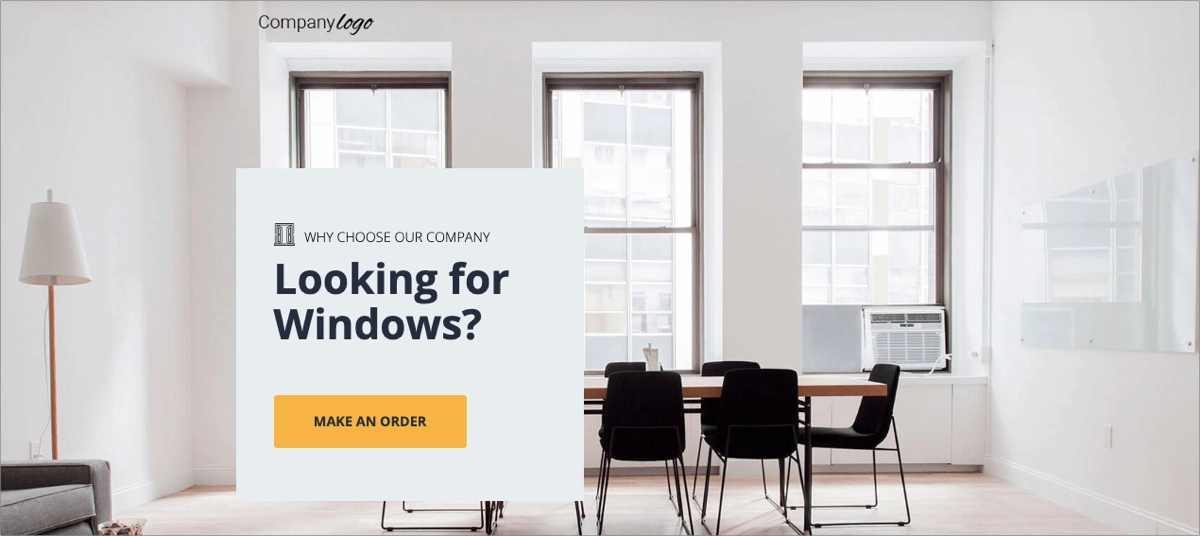
4 Facebook Landing Page Best Practices
To maximize the effectiveness of your Facebook landing page, consider the 4 best practices for Facebook landing pages boosting engagement and ultimately leading to higher conversion rates. These strategies will greatly enhance your brand’s presence on social media and help cultivate a community of engaged followers and customers. These practices are designed to make your Facebook landing page not just a point of interaction but a pivotal element of your digital marketing strategy.
#1 Keep messaging consistent
The first best practice for Facebook landing pages is to keep messaging consistent. Ensure it aligns closely with the ads that direct users there. This consistency in messaging builds trust and sets clear expectations, reducing bounce rates and increasing the likelihood of conversion. When users click on an ad, they expect to see a continuation of the promise or offer that initially caught their attention. If the landing page deviates from this expectation, it can create confusion and mistrust, prompting potential customers to leave before taking action.
Take a look at the example below:
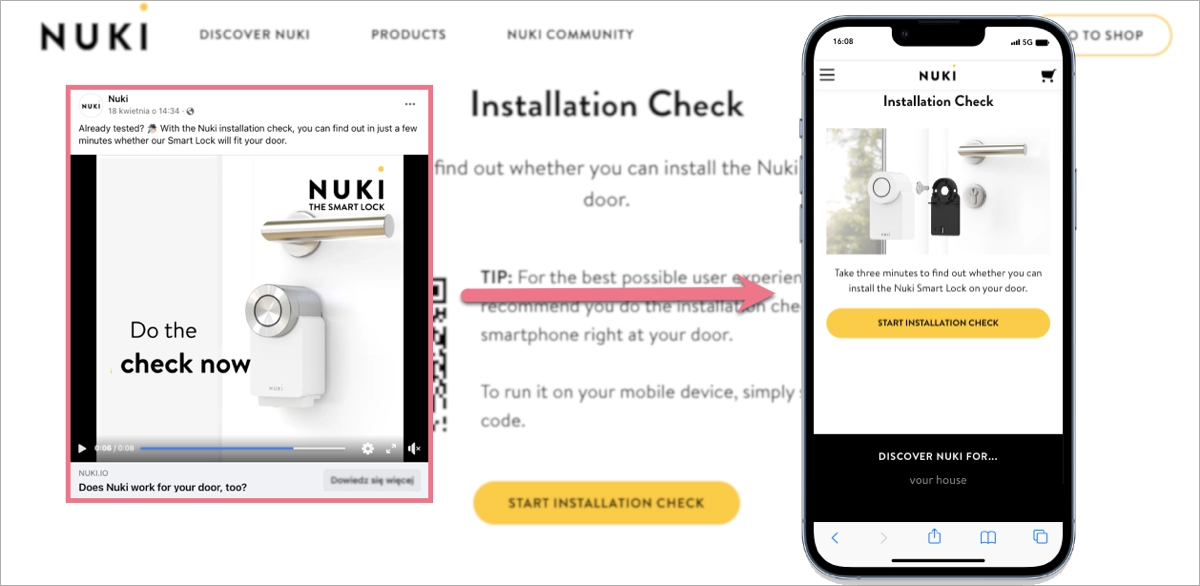
Additionally, keep the overall aesthetics aligned. Use the same color schemes, fonts, and imagery style on your landing page as you do in your ads. Visual consistency not only reinforces your brand identity but also plays a significant role in user recognition and the reinforcement of their decision to click the ad in the first place.
#2 Use a strong CTA and clear forms
The second best practice for Facebook landing pages is to use a strong CTA and clear forms. Ensure the CTA is visible without scrolling too much, especially on mobile devices. A well-crafted CTA catches the eye and clearly communicates what steps users should take next. To maximize the effectiveness of your CTA, consider the following strategies:
- Visual Prominence
- Action-Oriented Language
- Strategic Placement
- Size and Design
Pay attention to creating simple forms that resonate with your target audience and campaign goal. Use clear patterns, add visual elements like icons when possible, and ensure your forms do not require any sensitive data.
Take a look at the example below:
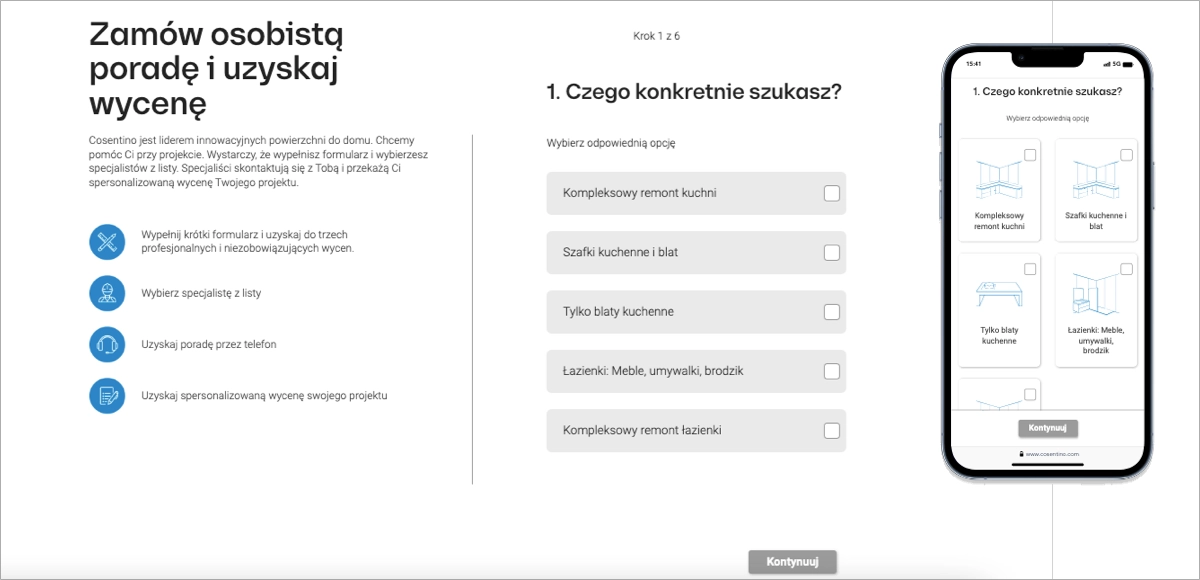
Additionally, the forms for capturing user information, like names, email addresses, or phone numbers, should be as clear and concise as possible. This involves:
- Minimizing Fields
- Clear Labels
- Privacy Assurance
#3 Optimize for fast loading times
The third best practice for Facebook landing pages is to optimize them for fast loading times. Speed is critical, especially on mobile. Mobile users often have less patience for slow-loading pages, especially when browsing on the go. Optimize your landing page to load quickly by compressing images, reducing unnecessary code, and using a reliable hosting service. Follow these strategies to adjust your Facebook landing page loading time for user expectations:
- Use image compression tools to reduce file sizes without sacrificing quality.
- Streamline the HTML, CSS, and JavaScript on your page. Remove unnecessary or redundant code, and use minification tools to reduce the size of code files.
- Use a Content Delivery Network (CDN).
- Where possible, use asynchronous loading for JavaScript to prevent it from blocking the display of elements on your page.
- For CSS, avoid using @import calls, as they can add additional waiting time for page rendering.
- Set appropriate time limits for caching different types of content (like images and scripts).
- Invest in a reliable hosting provider that can guarantee high uptime and quick server response times.
- Use tools like Google PageSpeed Insights to test your landing page’s loading speed regularly.
- Ensure your landing page design is responsive and adapts seamlessly to different device sizes and resolutions.
Focusing on these areas can significantly improve the loading speed of your Facebook landing page. Faster loading enhances user experience and contributes to higher SEO rankings, reduced bounce rates, and improved overall performance of your digital marketing campaigns.
#4 Incorporate visuals and videos
The fourth best practice for Facebook landing pages is to incorporate visuals and videos. Those can convey your message more effectively than text alone. Include high-quality images or an engaging video that explains your product or service succinctly. This visual appeal can capture attention and help explain complex information more easily – visual elements are processed 60,000 times faster in the brain than text, making them crucial for capturing and retaining visitor attention.
Take a look at the example below:
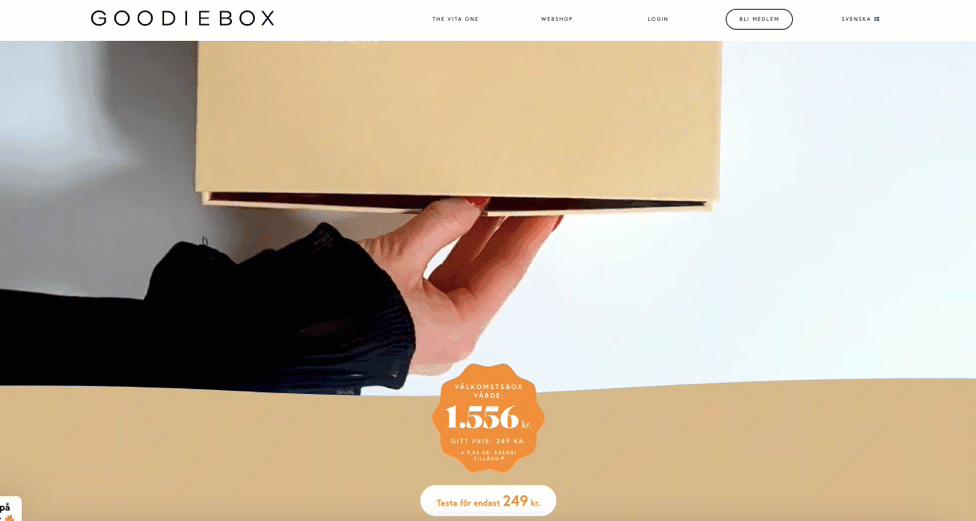
Choose sharp, high-resolution images that are relevant to your content. These images should reflect the message you want to convey and resonate with your target audience. For example, if you’re promoting a fitness program, use dynamic images of people engaging in exercise that your audience can aspire to.
Eventually, videos are the most effective way to deliver a complex message quickly and engagingly. A concise, well-produced video explaining your product or service can increase user understanding and retention of information. Ensure your videos start with a captivating hook within the first few seconds to keep viewers engaged.
How to Optimize Facebook Landing Pages for Higher Conversion Rates?
To optimize your Facebook landing page for higher conversion rates, focus on audience relevance, enhance visual appeal, streamline the user journey, and use retargeting techniques – and, of course, don’t forget about ongoing optimization. Learn the 10 proven optimization strategies described below to achieve the best results:
1. Focus on audience relevance
Firstly, focus on audience relevance – tailor your landing page content to match the interests and needs of your target audience. Use data-driven insights from your Facebook campaigns to understand demographics, preferences, and behavior patterns. This will help you create content that resonates deeply, increasing the likelihood of conversion.
2. Enhance visual appeal
Secondly, enhance visual appeal – utilize high-quality images, engaging videos, and a consistent color scheme that aligns with your brand. Visuals should capture attention and complement the message without overwhelming the text. Ensure they are optimized for fast loading and visually appealing on both desktop and mobile devices.
3. Streamline the user journey
Thirdly, streamline the user journey – simplify the path to conversion by reducing the number of steps needed to complete an action. This might include minimizing form fields, using clear and compelling CTAs, and eliminating unnecessary navigation or links that might distract from the conversion goal.
4. Use persuasive copy
Fourthly, use persuasive copy – employ clear, concise, and compelling text sections that communicate the benefits of your offer. Your headlines should grab attention, and your body copy should persuade visitors to act. Utilize persuasive writing techniques such as highlighting the offer’s urgency, deficiency, or exclusivity.
5. Optimize for mobile
Fifthly, optimize your page for mobile – mere Facebook users access the site via mobile devices, so you must ensure your landing page is fully responsive. This means fast load times, mobile-friendly layouts, and CTAs that are easy to navigate on a smaller screen.
6. Implement strong CTAs
Sixthly, implement strong CTAs – your call to action should be obvious (saying what the user should do next) and enticing. Use vibrant colors to make your CTA buttons stand out, and position them strategically on the page. Ensure that the language is action-oriented, creating a sense of urgency or benefit by completing the action.
7. Incorporate social proof
Seventhly, incorporate social proof – add elements such as testimonials, reviews, and social shares to build credibility and trust. Seeing that others have had a positive experience with your product or service can significantly influence new visitors to convert.
8. Conduct A/B testing
Eighthly, conduct A/B testing – regularly test different elements of your landing page, including images, CTAs, copy, and layouts, to see what works best with your audience. It will allow you to make data-driven decisions that can enhance the performance of your landing page over time.
9. Use retargeting techniques
Ninthly, use retargeting techniques – implement a Facebook Pixel on your landing pages to capture visitor information. Use this data for retargeting campaigns to draw back visitors who didn’t convert on their first visit.
10. Monitor and analyze performance
Tenthly, monitor and analyze page performance – track the performance of your landing page using tools like Facebook Analytics, Google Analytics, or tailored to landing page monitoring solutions like EventTracker from Landingi. Look at metrics such as bounce rates, conversion rates, and the average time on the page to identify areas for improvement.
As long as you implement these strategies, you can optimize your Facebook landing pages for higher conversion rates, effectively turning visitors into leads or customers while enhancing the ROI of your digital marketing efforts.
FAQ – Facebook Landing Page
Grab a handful of information and check out the answers to frequently asked questions – get the details of creating effective Facebook landing pages and clear your doubts with our explanations.
How to Create Social Media Landing Pages?
To create an effective social media landing page, you need to use a targeted approach that is in line with the specifics of social media traffic, usually characterized by short attention spans and a desire for instant gratification. Crucial steps before starting the landing page creation process involve understanding your audience and defining landing page goals to set up landing page type and its purposes. While designing your landing page, focus on its concise but engaging copy and immersive visual side. Your page should be well-optimized for mobile to ensure a seamless experience for all users.
Landing page crafting itself requires selecting the right builder, providing all necessary features, and enabling integrations with your already existing marketing toolkit. The best choice is Landingi, as it allows for seamless optimization with its built-in solutions and broad integration availability. You can select from other landing page builders, but they might not provide as many advanced features also tailored for inexperienced users and designed to streamline the optimization process.
Remember about ad relevance – landing page design, message, and the goal should align with the Facebook ads you use to direct users to the page.
What Is the Difference Between an FB Lead Form and a Landing Page?
An FB Lead Form is integrated within Facebook, allowing users to submit information without leaving the platform. It’s quick and optimized for mobile use, collecting data like name and email directly. In contrast, a landing page is a separate web page designed to provide detailed information and encourage specific actions, offering more space for content and customization.
Do I Need Landing Pages for Facebook Ads?
You don’t, but you should know creating landing pages for Facebook ads is the best solution for driving successful campaigns for several reasons, as follows:
- Better information delivery
- Enhanced user experience
- Single-goal campaign optimization
- Easier campaign success measurement
- Better targeting and personalization
- Increased credibility and trust
Landing pages are highly recommended for Facebook ad campaigns as they provide a targeted destination for your ad traffic, allowing for more detailed information and tailored calls-to-action that are not possible within the Facebook ad itself. This specificity enhances user engagement and significantly increases the chances of converting visitors into leads or customers.
What Is the Purpose of a Facebook Landing Page?
The purpose of a Facebook landing page is to create a targeted environment that enhances the effectiveness of your Facebook advertising or promotional campaigns. Specifically, a Facebook landing page serves several key functions:
- Converting visitors into leads or customers – by making it clear what action visitors should take.
- Providing detailed information – unlike a brief Facebook ad, a landing page offers the space to showcase the details of your product, service, or offer.
- Enhancing user experience – you create a seamless transition that improves user experience by directing users from an ad to a relevant landing page.
- Improving campaign performance tracking – landing page allows for detailed tracking and analytics crucial for assessing the effectiveness of your campaign and making data-driven improvements.
- Segmenting and personalizing user engagement – landing pages can be customized to target different segments of your audience based on the data from Facebook ads.
Overall, a Facebook landing page acts as a bridge between your Facebook ads and your business goals, optimizing the path from initial interest to conversion.
How to Optimize Facebook Landing Pages for Higher Conversion Rates?
To optimize Facebook landing pages for higher conversion rates, focus on clear, compelling content and strong calls-to-action that guide users toward your desired outcome. Ensure your page loads quickly, especially on mobile devices, and utilize A/B testing to refine elements like layout, copy, and visuals based on user feedback and analytics. Incorporate social proof like testimonials and user reviews to build trust and credibility, significantly boosting conversion rates.
Get 111 Landing Page Examples—The Ultimate Guide for FREE
What to Avoid while Creating a Facebook Landing Page?
When creating a Facebook landing page, avoid common pitfalls that can detract from its effectiveness, as follows:
- Overwhelming Content: Keep content concise; avoid clutter.
- Slow Load Times: Optimize images and scripts to ensure quick loading.
- Weak CTAs: Use strong, clear calls to action, not vague or hidden ones.
- Inconsistent Messaging: Ensure your landing page aligns with the ads leading to it.
- Ignoring Mobile Users: Design first for mobile, considering most Facebook traffic is mobile.
How do Facebook Landing Pages Integrate with Facebook Pixel or Other Tracking Tools?
Facebook landing pages can integrate seamlessly with Facebook Pixel and other tracking tools to enhance analytics and ad targeting. By embedding the Facebook Pixel code on your landing page, you can track user interactions, such as page views, form submissions, and purchases.
This data allows for precise retargeting and a deeper understanding of conversion metrics, helping to optimize your ad campaigns for better performance and ROI. Additionally, integration with tools like Google Analytics provides broader insights into traffic sources and user behavior. You can also use built-in landing page tracking features to measure its success and test various versions by selecting a professional builder, like Landingi.
Can I Use Facebook Landing Pages for A/B Testing?
Yes, you can use Facebook landing pages for A/B testing to optimize your campaigns and improve conversion rates. A platform like Landingi offers robust A/B testing features, allowing you to compare different versions of your landing page directly. This enables you to test various elements, such as headlines, images, and calls-to-action to determine which combinations work best with your target audience.
What Are the Legal or Compliance Considerations for Facebook Landing Pages?
For Facebook landing pages, legal and compliance considerations primarily revolve around data protection and privacy laws, such as GDPR in Europe and CCPA in California. Ensure that your landing pages comply by:
- Clearly displaying privacy policies – inform users about how their data will be used.
- Obtaining explicit consent – use clear opt-in methods for collecting personal information.
- Providing user data access and deletion options – allow users to see or request deletion of their data.
- Adhering to advertising standards – follow Facebook’s advertising guidelines and local advertising laws.
Staying compliant not only protects your users but also builds trust and enhances your brand’s reputation.
How to Personalize Facebook Landing Pages for Different Audiences or Ad Campaigns?
To personalize Facebook landing pages for different audiences or ad campaigns, consider the following strategies:
- Segment your audience – divide your audience based on demographics, interests, behaviors, or past interactions with your brand. Utilize Facebook’s audience insights to gather data and define these segments.
- Tailor content to user preferences – customize the content of the landing pages to appeal to the specific interests and needs of each segment. This could involve altering images, text, and offers to resonate more strongly with different groups.
- Use dynamic content – create content that automatically adjusts based on the visitor’s profile. For example, show different content to first-time visitors versus returning customers.
- Conduct A/B testing – continuously test various elements of your landing pages (like headlines, CTAs, images, and layouts) to see what performs best with different audience segments. This will help you refine your approach and increase the effectiveness of your personalization.
- Set up integration with CRM – link your landing pages to your customer relationship management (CRM) system to leverage existing data on your customers. This allows for even more personalized content and offers based on the user’s history with your brand.
- Use localized versions – customize your landing pages with local languages, cultural references, and region-specific offers to increase relevance and engagement.
With these strategies, your Facebook landing pages will be highly personalized and effective at converting different segments of your audience, thereby maximizing the ROI of your ad campaigns.
Create a Facebook landing page with Landingi
Much like crafting a targeted marketing strategy, your Facebook landing page requires a thoughtful blend of enticing visuals and compelling content aligned with ads to drive meaningful interactions and conversions.
Creating an attractive and informative landing page is just the start. It’s ongoing optimization that serves as an essential point for maximizing conversion rates and strengthening your brand’s presence on social media. By applying best practices and utilizing advanced digital tools, you have the power to create a standout Facebook landing page.
Try Landingi now – build your Facebook landing page and watch it transform into a powerful vehicle for business growth, drawing in your audience and engaging them in a more profound and lasting way.

